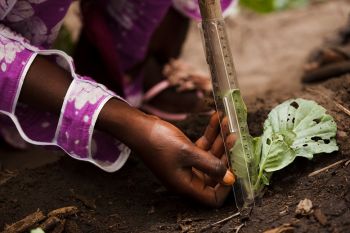
The Global Confederation of Higher Education Associations for Agricultural and Life Sciences (GCHERA) co-organized from 15-17 June, 2015 in Zaragoza, Spain the conference "Agricultural Higher Education in the 21st Century" in which Young Professionals for Agricultural Development (YPARD) participated. GFAR supports this nice GCHERA-YPARD collaboration as both are members of GFAR Steering Committee.
A question asked to primary school children? No, indeed this was something I asked myself when attending this conference. Deans and professors of international universities gathered at the Mediterranean Agronomic Institute of Zaragoza (IAMZ-CIHEAM) to discuss about how to renew agricultural higher education in order to prepare efficient professionals that will face the challenging future of how feeding a growing population in a sustainable way.
Everyone showed figures about the increase of population in the forthcoming decades and how the environmental context is becoming more and more vulnerable. The main challenge of feeding a growing population will happen in Africa and South East Asia particularly. Thus the question is: What are we going to do if the universities of these regions are out of the decision arena because of financial problems? Who will be responsible for this?
Attracting Youth to the Agricultural Sector
Most of the institutions that attended the event seem to be facing the same issue: the lack of young people willing to engage in agriculture. Paradoxically universities are refusing candidates in their recruitment processes due to the lack of excellence. Thus there’s a gap between the preparation of the students in high school and what they are asked to demonstrate for entering higher education institutions.
The main suggestion to tackle this point was to turn the name and curriculum of the given degrees more towards “bio-technology” and above all make the word “agriculture” disappear. “It is not attractive at all, it is old fashioned and youngsters are not attracted by it anyway!” expressed one of the participants.
I don’t agree. The word “food” is appealing and takes the whole agricultural value chain into account, even the non-food products as it makes us understand that the objective is to link and reunite society with agriculture. Students and young people in general are more and more concerned about the accessibility of food, even more than about availability. Could be this the problem to tackle at a global level?
Employability – A problem?
What do African universities think about this? Are these willing to prepare their students to address the problem of accessibility or the one of availability? Will these prepare agricultural professionals that will have to tell to smallholders in Africa that are indeed suffering from hunger: “don’t worry; it’s only that we produce too much somewhere and not enough here”? What should be the approach?
I was surprised to learn that there are more positions to fulfill than graduates on the job market. Are people unemployed that I know blind without being aware of it? Every presentation of the different institutions represented during the event showed almost a 100% rate of employment among their graduates. I guess we are all keen on making statistics work for us.
What is employability and what should we understand by it? The issue of employability is about answering to the question if graduates are getting the jobs they were prepared for and the ones they are targeting indeed. So, if an agronomist in Nigeria finishes on a petrochemical company, is this a good employability result because he managed to get adapted to a completely new working environment? Or is it a very bad employability result indeed because he finished doing something we didn’t prepare him for?
Soft Skills – Key for future agricultural professionals
New competences will be more and more in the field of soft skills. For delivering this new set of skills teaching methods must evolve. Therefore it’s urgent to embrace innovation at the pedagogical level. As a result lecturers are asked to transfer their knowledge in an excellent way but: one,
- Are they only evaluated for their research activity? How do we want them to spend time on preparing their courses instead of publishing articles?
- They have never been taught how to teach. In addition it’s becoming more frequent to find them managing big projects and so carrying out a heavy administrative workload. There is a big point here to be undertaken by higher agricultural education Institutions.
Above all, still one more conference full of grey hair professionals. I was proud to see that the two single organizations invited to bring the voice of youth to the debate were represented by two young women: Lisanne Meulendijks, IAAS Communication vice-president and I, YPARD France representative.
Back to the beginning
What are the skills that young agriculturalists will need to be able to take action in this challenging and changing agricultural context? How to identify these new competencies? Present curricula needs to evolve but in the academic world a theoretical approach often overtakes the pragmatic response of the job market for curriculum development.
YPARD was asked to bring the answer to these questions from the field. Multidisciplinary degrees seem to be the future answer to these needs of new competencies for the new professionals. But with the time given for master classes, how to manage to go deep enough into each of the identified disciplines? Once again, innovative pedagogical tools are at the core of the question. See our presentation titled “Building capacities for agricultural challenges of the 21st century.”
The two days were full of very rich exchanges and it was a high quality compilation of good practices to address the asked question, the ball is on in Higher Agricultural education Institutions’ court now. I hope this appointment will become a major milestone on the adaption of agricultural curricula to the future new landscape.
By Myriam Pérez, YPARD France representative
Picture credit: @FAO/Olivier Asselin
Source: YPARD
